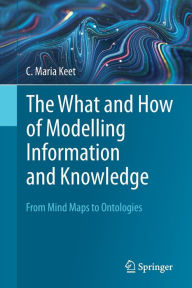The What and How of Modelling Information and Knowledge: From Mind Maps to Ontologies. C. Maria Keet

The-What-and-How-of.pdf
ISBN: 9783031396946 | 177 pages | 5 Mb

- The What and How of Modelling Information and Knowledge: From Mind Maps to Ontologies
- C. Maria Keet
- Page: 177
- Format: pdf, ePub, fb2, mobi
- ISBN: 9783031396946
- Publisher: Springer Nature Switzerland
Free download ebooks in english The What and How of Modelling Information and Knowledge: From Mind Maps to Ontologies 9783031396946
The main aim of this book is to introduce a group of models and modelling of information and knowledge comprehensibly. Such models and the processes for how to create them help to improve the skills to analyse and structure thoughts and ideas, to become more precise, to gain a deeper understanding of the matter being modelled, and to assist with specific tasks where modelling helps, such as reading comprehension and summarisation of text. The book draws ideas and transferrable approaches from the plethora of types of models and the methods, techniques, tools, procedures, and methodologies to create them in computer science. This book covers five principal declarative modelling approaches to model information and knowledge for different, yet related, purposes. It starts with entry-level mind mapping, to proceed to biological models and diagrams, onward to conceptual data models in software development, and from there to ontologies in artificial intelligence and all the way to ontology in philosophy. Each successive chapter about a type of model solves limitations of the preceding one and turns up the analytical skills a notch. These what-and-how for each type of model is followed by an integrative chapter that ties them together, comparing their strengths and key characteristics, ethics in modelling, and how to design a modelling language. In so doing, we’ll address key questions such as: what type of models are there? How do you build one? What can you do with a model? Which type of model is best for what purpose? Why do all that modelling? The intended audience for this book is professionals, students, and academics in disciplines where systematic information modelling and knowledge representation is much less common than in computing, such as in commerce, biology, law, and humanities. And if a computer science student or a software developer needs a quick refresher on conceptual data models or a short solid overview of ontologies, then this book will serve them well.
The What and How of Modelling Information and Knowledge
It starts with entry-level mind mapping, to proceed to biological models and diagrams, onward to conceptual data models in software development, and from there
The What and How of Modelling Information and
The main aim of this book is to introduce a group of models and modelling of information and knowledge comprehensibly. The book draws ideas and transferrable
On Ontological Modeling of Measurements in a Complex
5) the branches form a connected nodal structure. Four low-level ontologies are depicted as mind maps in Guarino, ”Formal Ontology and Information Systems” in.
(PDF) Empirical Validation of Concept Maps
Concept maps is defined as a model of current knowledge about the world in a given domain and given context (Albert and Steiner, 2005) . Compared to other
From Mind Maps to Ontologies (Paperback)
Home · The What and How of Modelling Information and Knowledge: From Mind Maps to Ontologies (Paperback)
[PDF] Ontology-driven mindmapping
A mindmapping tool driven by semantic web ontologies that allows to assign meanings to the mindmap nodes and guide the user through mindmap creation by
View of a concept map. Adapted with permission from [10].
Incorporation of ontologies into annotations has enabled 'semantic integration' of complex data, making explicit the knowledge within a certain field.
Summarizing the ontology classifications in a mind-map.
Ontology was chosen as the contemporary most comprehensive knowledge representation and codification model. Our approach uses participatory action research
COE ontology map interface. Links to other
It bridges the gap between the informal nature of concept maps and the formal machine-readable Web ontology languages (Hayes et al., 2005) , by making use of a
The What and How of Modelling Information
The main aim of this book is to introduce a group of models and modelling of information and knowledge comprehensibly. Such models and the processes for how
MIND – Semantic Based Knowledge Visualization
Knowledge, Information and Data have always been of importance in human knowledge map, MIND provides zoom in/zoom out, roll up/roll down (of links)
Concept map
Concept maps have been used to define the ontology of computer systems, for example with the object-role modeling or Unified Modeling Language formalism.
[PDF] Developing a Formal Model for Mind Maps
A formal mind map model aiming to describe the structure, content, semantics and social connections is presented, which will support the
From Brain Maps to Cognitive Ontologies: Informatics and
Ontologies are generally specified using formal knowledge representation systems, or ontology languages, such as the Ontology Web Language. Once specified this
Download more ebooks:
DOWNLOAD [PDF] {EPUB} Drawing Anime Faces and Feelings: 800 facial expressions from joy to terror, anger, surprise, sadness and more by Studio Hard Deluxe
0コメント